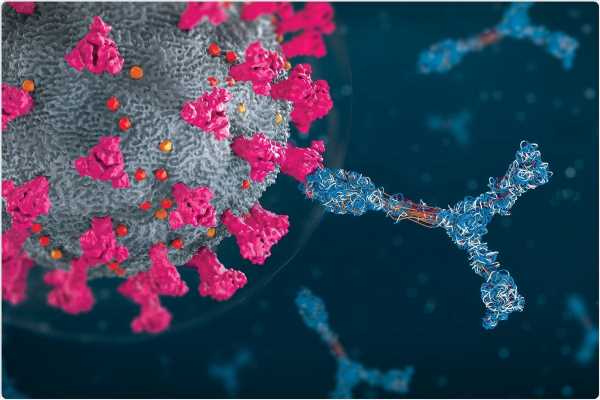The severe acute respiratory syndrome coronavirus (SARS-CoV-2) infection initiates a series of defense mechanisms in the human body that are collectively known as the adaptive immune response. The adaptive immune response can be further subdivided as the humoral, or antibody-based, immune response and cellular immune response, which is mediated by specific immune cells.

Study: Concordance of B and T cell responses to SARS-CoV-2 infection, irrespective of symptoms suggestive of COVID-19. Image Credit: Cristoph Burgstedt / Shutterstock.com
Background
Humoral immunity begins to develop two to three weeks post-infection. The initial stage of this immune response is marked by the production of immunoglobulin M (IgM), followed by IgG within several days. The most common target for antibodies is the SARS-CoV-2 spike protein, which is also the primary target of current coronavirus disease 2019 (COVID-19) vaccines; however, neutralizing antibodies produced by the humoral immune response can also target the viral nucleocapsid protein.
Measuring the neutralizing antibody response helps in assessing the virus-combatting potential of an individual’s convalescent serum. The cellular response, on the other hand, complements the humoral arm of the immune response, with the help of special immune cells including T-cells, particularly the CD4+ T subset.
Acute COVID-19 elicits antibody responses in most patients. However, a subset of patients who have experienced symptoms that are suggestive of COVID-19, as well as certain “long COVID” patients, do not have detectable levels of antibodies. One possible explanation for this lack of detectable antibody levels might be the lack of sensitivity and specificity of test methods used to measure these antibodies, as well as the potential for antibody levels to decline with time.
In a recent study published on the preprint server medRxiv,* researchers assess a possible correlation between humoral and cell-mediated responses to SARS-CoV-2 in symptomatic and asymptomatic individuals in the United Kingdom.
About the study
In the current study, researchers collected data from the TwinsUK cohort and the COVID Symptom Study (CSS) cohort. TwinsUK has over 14,000 registered individuals, of which include over 7,000 twins.
A total of 431 individuals from the TwinsUK cohort participated in a home visit study between May 2020 and June 2020. Of these 431-home visit-study participants, 384 had also participated sufficiently in the CSS. CSS data was used to form a ‘symptom score,’ with the scale ranging from 0 to 1.0. A score above 0.5 on this scale denoted “Symptom-Positive” COVID-19.
All participating individuals were grouped into four categories based on symptom score and anti-spike IgG antibody responses from the initial home visit. The groups consisted of individuals who were “symptom-positive” for COVID-19 and exhibited a positive antibody response (Group 1), individuals who were “symptom-positive” for COVID-19 but antibody-negative (Group 2), individuals who were “symptom-negative” for COVID-19 with a positive antibody response, thus indicating asymptomatic infection (Group 3), and individuals who were “symptom-negative” for COVID-19 and antibody-negative, thereby implying the healthy control group (Group 4).
By the end of the study, nine individuals were included in Group 1, 12 individuals were included in Group 2, with Groups 3 and 4 consisting of six and five individuals, respectively.
All study participants provided their sera for analyzing the levels of spike and nucleocapsid antibodies, as well as their T-cell responses. At their second visits, the participants again provided sera samples, which were used to isolate peripheral blood mononuclear cells (PBMCs) and repeat antibody testing.
Study findings
None of the 17 antibody-negative individuals, which included those in Groups 2 and 4, exhibited a T-cell response when their sera were tested against antigen pools that corresponded to the SARS-CoV-2 matrix and nucleocapsid proteins, as well as the S1 and S2 domains of the spike protein. Comparatively, 14 of the 15 individuals who were antibody-positive exhibited a clear T-cell mediated immune response against these viral antigens.
The researchers also found that anti-spike IgG levels correlated strongly to T-helper cell responses as compared to their associated with T-regulatory cell levels. Although this response is not surprising, as T-helper cells play an important role in the generation of B-cell antibody responses, a strong correlation between T-helper and T-regulatory responses was also observed.
Notably, all antibody-negative individuals also did not exhibit a T-cell response to SARS-CoV-2 infection, regardless of whether they reported experiencing COVID-19-like symptoms.
Implications
The strong correlation observed between anti-spike IgG levels and T-cell responses demonstrates that T-cell testing is not likely to add any information regarding individual immunity to SARS-CoV-2 when used in addition to measuring neutralizing antibody levels. However, since T-cell reactivity and antibody levels may differ at later time points, it may be useful for researchers to assess how the T-cell response compares to waning antibody levels after several months following infection and/or vaccination.
*Important notice
medRxiv publishes preliminary scientific reports that are not peer-reviewed and, therefore, should not be regarded as conclusive, guide clinical practice/health-related behavior, or treated as established information.
- Österdahl, M. F., Christakou, E., Hart, D., et al. (2022) Concordance of B and T cell responses to SARS-CoV-2 infection, irrespective of symptoms suggestive of COVID-19. medRxiv. doi:10.1101/2022.02.03.22270393. https://www.medrxiv.org/content/10.1101/2022.02.03.22270393v1.
Posted in: Medical Science News | Medical Research News | Disease/Infection News
Tags: Antibodies, Antibody, Antigen, Blood, CD4, Cell, Coronavirus, Coronavirus Disease COVID-19, covid-19, Immune Response, immunity, Immunoglobulin, Protein, Respiratory, SARS, SARS-CoV-2, Severe Acute Respiratory, Severe Acute Respiratory Syndrome, Spike Protein, Syndrome, T-Cell, Twins, Virus

Written by
Sreetama Dutt
Sreetama Dutt has completed her B.Tech. in Biotechnology from SRM University in Chennai, India and holds an M.Sc. in Medical Microbiology from the University of Manchester, UK. Initially decided upon building her career in laboratory-based research, medical writing and communications happened to catch her when she least expected it. Of course, nothing is a coincidence.
Source: Read Full Article
